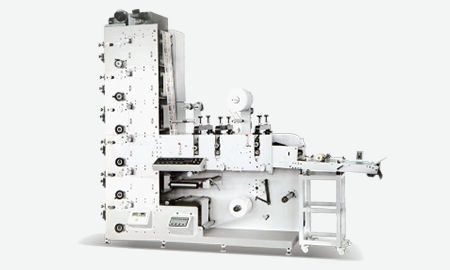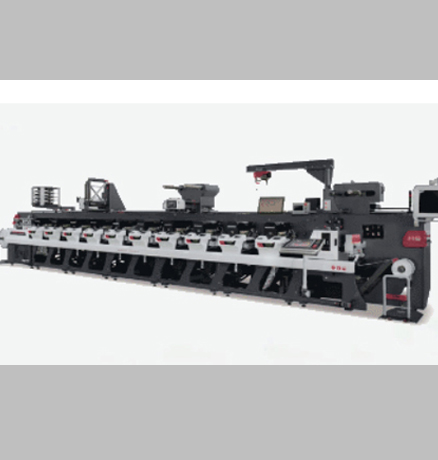Flexographic printing, often referred to as flexo printing, is a versatile and widely used printing technology in various industries, particularly for packaging applications. At the heart of this technology lies the flexo printing press, a sophisticated machine designed to transfer ink onto a wide range of substrates using flexible relief plates. This article will delve into the definition, working principles, key components, and technological advancements of flexo printing presses.
A flexo printing machine is a mechanical device that utilizes flexible relief plates to apply ink onto different substrates during the printing process. The term "flexo" originates from the flexible nature of the printing plates, which are typically made from rubber or photopolymer materials. These plates have raised image areas that hold the ink, while the non-image areas are recessed, allowing for precise ink transfer. Flexo presses are capable of handling various printing tasks, from simple line work to complex graphics, and can operate at high speeds, making them ideal for large-scale production runs.
The working principle of a flexo printing machine revolves around the transfer of ink from the ink fountain to the substrate through the flexible relief plates. Here is a step-by-step breakdown of the process:
1. Ink Application: Ink is first introduced into the ink fountain, which is connected to an anilox roller. The anilox roller, a key component with engraved cells on its surface, picks up a measured amount of ink from the fountain. The cells' volume determines the amount of ink transferred, allowing for precise control over the ink layer thickness.
2. Plate Inking: The inked anilox roller then comes into contact with the flexo printing plate. The raised image areas of the plate absorb the ink from the anilox roller, while the non-image areas remain ink-free.
3. Substrate Printing: The inked plate is then pressed against the substrate, which is moving through the press. The pressure applied during this contact transfers the ink from the plate to the substrate, creating the desired printed image. In multi-color printing, each color is applied sequentially using separate printing units, with registration systems ensuring accurate alignment of each color layer.
Flexo printing machines can use a variety of inks, depending on the substrate and the application requirements. Some common types of inks include:
1. Water-based Inks: These are environmentally friendly and widely used due to their low volatile organic compound (VOC) emissions. They are suitable for printing on porous substrates such as paper and cardboard, providing good adhesion and vibrant colors.
2. Solvent-based Inks: These inks offer excellent performance on non-porous substrates like plastic films. They dry quickly and provide good resistance to chemicals, abrasion, and heat. However, they have higher VOC emissions, which have led to increased regulations in some regions.
3. UV-curable Inks: UV inks are cured instantly using ultraviolet light, resulting in high-quality, durable prints with excellent gloss and color intensity. They can be used on a wide range of substrates, including paper, plastic, and metal, and are known for their resistance to fading and scratching.
4. Specialty Inks: There are also specialty inks available for specific applications, such as metallic inks for creating shiny effects, fluorescent inks for high-visibility printing, and edible inks for food packaging.
One of the major advantages of flexo printing is its ability to print on a diverse range of substrates, both porous and non-porous. Some common substrates include:
1. Paper and Cardboard: This includes various types of paper such as newsprint, bond paper, and cardboard used for packaging boxes, labels, and cartons.
2. Plastic Films: Flexo printing is widely used on plastic films like polyethylene (PE), polypropylene (PP), polyvinyl chloride (PVC), and polyester (PET). These films are used in applications such as flexible packaging, shrink wraps, and labels.
3. Metalized Films and Foil: Metalized substrates are used to create a metallic look in packaging, adding a touch of luxury and enhancing product visibility.
4. Fabrics: Some flexo machine are capable of printing on fabrics, such as those used for banners, flags, and promotional materials.
5. Laminates: Laminated substrates, which are made by bonding two or more layers of different materials, are also commonly printed using flexo technology, providing enhanced properties such as barrier protection and durability.
Prepress is a crucial stage in the flexo printing process that involves preparing the digital artwork for printing. The main steps in prepress include:
1. Design and Layout: The artwork is created using graphic design software, ensuring that all elements such as text, images, and colors are properly formatted and sized for the intended substrate and application.
2. Color Separation: The multi-color artwork is separated into individual color channels (typically CMYK - cyan, magenta, yellow, and black), along with any spot colors required. This separation is done using specialized software that converts the digital image into a format suitable for plate making.
3. Proofing: A proof of the printed image is created to allow the customer to approve the color, layout, and overall quality before proceeding to plate making. This can be done using digital proofing techniques or by creating a physical proof on the intended substrate.
4. Plate Data Preparation: The separated color files are used to generate the data required for creating the flexo printing plates. This includes creating the mask or film positives that will be used in the plate-making process.
Proper press set up is essential for achieving high-quality prints and efficient production. The main steps in press set up include:
1. Plate Mounting: The flexo plates are carefully mounted onto the plate cylinders of each printing unit. Accurate mounting is crucial to ensure proper registration and prevent image distortion.
2. Anilox Roller Selection: The appropriate anilox roller is selected based on the ink type, substrate, and desired ink film thickness. The anilox roller is installed and aligned with the ink fountain and plate cylinder.
3. Substrate Feeding: The substrate is loaded onto the press's unwind station, and the tension control system is adjusted to ensure a smooth and consistent feed through the press.
4. Registration Adjustment: Registration marks on the substrate are used to adjust the position of each printing unit, ensuring that the different color layers align correctly. This is typically done using automatic registration systems that use sensors to detect the marks and make real-time adjustments.
5. Ink Preparation: The ink is mixed and adjusted to the correct viscosity and color, and then loaded into the ink fountains of each printing unit.
1. Digital Flexo: Hybrid systems combine flexo’s versatility with digital printing’s variable data capabilities.
2. High-definition plates: Achieve offset-like quality with sharper dots and gradients.
3. Automated workflows: AI-driven color matching and predictive maintenance reduce downtime.
4. Sustainable innovations: Water-washable plates, bio-based inks, and energy-efficient dryers.

Flexo printing machines are essential machines in the packaging and printing industries, offering versatility, efficiency, and high-quality printing on a wide range of substrates. With continuous technological advancements, flexo printing is poised to remain a leading printing technology, adapting to the evolving needs of the market in terms of quality, sustainability, and innovation.


GET A QUOTE